Dr. Steven Doty: Research Description
Astrophysics
Modeling: General
Astrophysics concerns itself with the Universe: where it came from,
how it works, and where it is going to. Unlike experiments in which
we can choose to set up any situation we desire, the all of the
experiments we study as astronomers/astrophysicists have already
been set up for us. As a result, we have to work backwards: we
must take the light from the stars (the experimental output) and
infer the situation that produced it (the experimental conditions).
This work is done by constructing detailed models of the physics
involved in regions around stars to predict the light we would
observe. By comparing the observations with the models, we can see
which models best fit the data -- and thus get a good idea about
the environments around stars.
Star Formation: 1-D
|
In my work, I am primarily interested in how and where stars
are born. This is called Star Formation. A region of
recent and massive star formation is in Orion's belt.
Orion (the Hunter) is easily visible to the naked eye in the
fall sky. It is one of the closest (~ 500 pc) and most studied
star-forming regions in our galaxy.
|
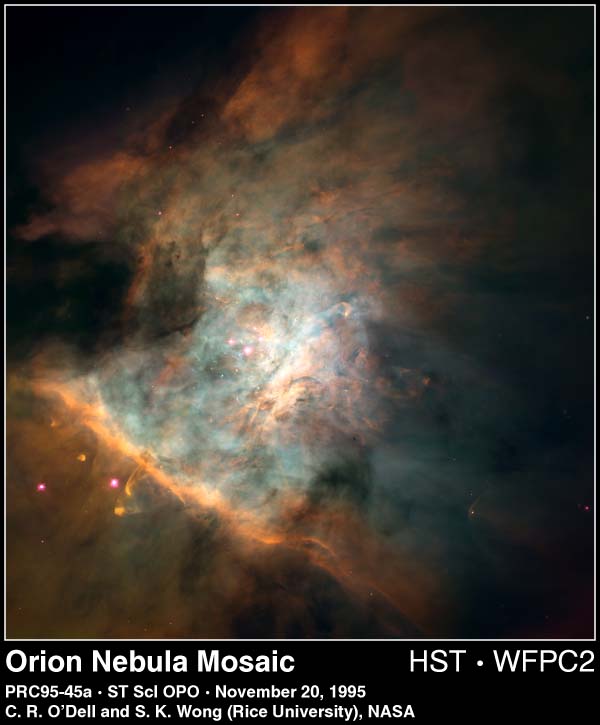 .
.
|
|
Most of the information we receive is in the form of infrared
(heat) radiation emitted by small, solid particles called
dust grains. These particles are about 1 micron or less
in radius -- about the size and composition of the particles in
cigarette smoke. They are heated by absorbing starlight,
warm up, and emit infrared radiation that we receive at the Earth.
We can observe this radiation by using both ground and space-based
observatories (green symbols to the right). By fitting the
data with models (solid line to the right) we can infer the
properties of the source. In this case, a fit to AFGL 2591 shows
tells us how strong the star is, how must material surrounds it,
and how centrally condensed the region is.
|
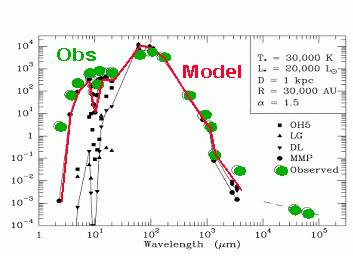 .
.
|
|
Aside from dust grains, there are also molecules in these regions
in which stars form. One important question is where is the
galactic oxygen? One potential place is water, since it is stable,
and since hydrogen is the most abundant cosmic element. We can
study the potential existence of water by seeing how much emission
there is around a star-forming region. In the panel to the right
we shown the observed emission by water masing (maser = laser that
emits microwaves instead of visible light) in Orion as a function
of position in the source. The observed data are given by the symbols
(dots), and the models are given by the solid lines. Note that by
observing one line we may be able to say something about the
amount of water -- namely that there is about 1 water molecule
for every million hydrogen molecules (x = 10^-6).
|
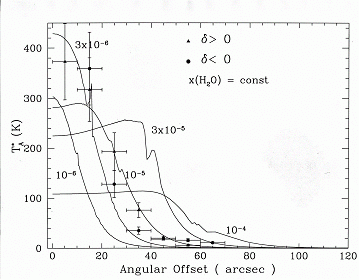 .
.
|
|
We can also get a better fit by including more data. In the panel
at the right, we show results from observations by the Infrared
Space Observatory (ISO) toward AFGL 2591. The lines here are
thousands of absorption lines of water, absorbing light emitted
by a hot source in the background (blue line). We fit all of these
lines simultaneously (red line). This model confirms the results
for total mass, luminosity, and density structure inferred by the
dust modeling above.
|
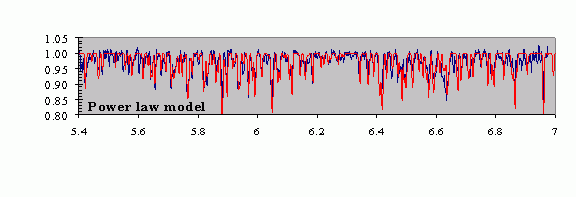 .
.
|
Star Formation: 3-Dimensions
|
Given the above results, it appears that we have a basic
understanding of the processes and principles involved in
the formation of stars. Recent data, however, show significant
irregularity in star-forming regions (consider the orion case
above). As a result, we are now considering the effects of
a three-dimensional source structure -- including clumps,
holes, disks, etc., on the emitted radiation. To the right
is an example -- HH30.
|
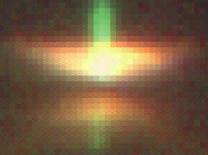 .
.
|
|
One recent piece of work has been the construction of a
fully three-dimensional simulation of the transfer of
radiation through irregular regions. As an example,
a simple "off the cuff" model to somewhat mimic HH30 is
shown to the right.
|
 .
.
|
|
What good is this? Well, in clumpy regions, the clumpy material
may block light, while the "holes" may let light through. As
a result, the temperature structure is not uniform. Instead,
hotspots may occur further into the region than might otherwise
be expected. Working with Matt Palotti ('02) we showed that
this may occur -- see the panel at the right.
|
 .
.
|
TO CONTACT ME
If you have any questions, please feel free to contact me. You can find me
at:
Dr. Steven Doty
Department of Physics and Astronomy
Olin 109
Denison University
Granville, OH 43023
You can also e-mail me at
doty@cc.denison.edu.
 .
.
 .
.
 .
.
 .
.